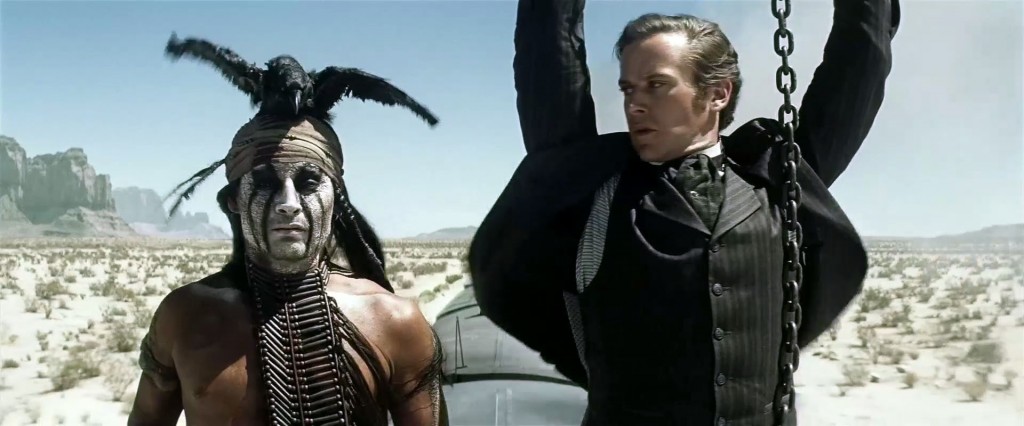Culture
Movie review: “The Lone Ranger”

The Lone Ranger
dir. Gore Verbinski
Release Date: Jul 03, 13
- 1
- 2
- 3
- 4
- 5
- 6
- 7
- 8
- 9
- 10
For the myriad failures of The Lone Ranger as both a riveting, action-packed summer tentpole and a piece of entertainment in general, the first and one of the most immediately noticeable is the framing device which surrounds it. At a San Francisco carnival in 1933, a young boy wanders into an exhibit on the Old West, where the creatures on display include a grizzly bear and the Noble Savage (a.k.a. the American Indian, and yes, this is as uncomfortable as it reads). This particular noble savage happens to be an aged Tonto (Johnny Depp), feeding seed to the dead bird on his headdress and half-lucidly mumbling about a former compatriot of his, one who’s since become a paragon of justice the world over: the Lone Ranger. The film returns to this device throughout, using it as a crutch to allow for the following:
1) Hackneyed comic relief.
2) A precocious child asking more questions than Ellen Page in Inception so that the film can cover its narrative gaps as it goes along.
3) Occasional breaking of the fourth wall, a stylistic trick that doesn’t suit the tone of the film at all.
4) The nadir of Johnny Depp’s career.
The Lone Ranger as a whole is told in flashback during the foundation of the trans-national railroad in 1869. Before the Lone Ranger put on the mask, he was the bookish John Reid (Armie Hammer), a well-trained lawyer returning to his tiny hometown of Colby, Texas as part of a prisoner transport for the mangy Butch Cavendish (William Fichtner), a sadistic train thief and all-around villain with a penchant for ingesting the innards of his victims. (We’re a long, long way from the quaint heroism of the television series.) Cavendish ends up making his escape, and John takes to the trail along with his brother Dan (James Badge Dale) to hunt the fugitive. Eventually Dan and the rest of the local Texas Rangers are murdered, John is left for dead and the criminals head into Comanche territory to break land treaties for reasons that the film takes far too long to clarify, especially given how obvious they are from about ten minutes in.
That’s to say nothing of the railroad tycoon (Tom Wilkinson) who has designs on Dan’s widow (Ruth Wilson), the Comanche warriors preparing for battle, the U.S. military troops called into Colby to maintain order or the spirit horse that starts following John around after he returns from the dead. A lot happens in The Lone Ranger, but very little of it leaves any sort of impact, in large part because of how little control Gore Verbinski’s film has over its tone. Verbinski here looks less like the assured mind behind the delirious Rango or the original Pirates of the Carribean and more like the bored workman behind the later Pirates sequels. While Verbinski at least knows how to competently shoot a big-ticket action sequence, especially an excellent setpiece near the film’s end with a trio of runaway trains, the rest of the film isn’t so fortunate. The film shifts tones at will, from wistful to grittily violent to comic and back again, sometimes in the same scene. At points this becomes actively offensive, particularly in a scene that starts with the detritus of dead Comanche warriors floating down a river and ends with a sight gag involving a horse in a tree.
There’s also the matter of Depp, who Verbinski led to one of his most memorable performances in the first Pirates film a decade ago and who may have been irreparably ruined by it ever since. His Tonto is clearly the star of The Lone Ranger, Hammer’s charmingly goofy performance notwithstanding, and he’s also one of its biggest weaknesses by far. The comic nuance of some of his best performances has long since turned into insufferable mugging, and actively distracts from sequences like Cavendish’s initial escape. No matter what’s happening onscreen, nothing in the film is regarded as deserving of more attention than Depp at any point. He infuses Tonto with a legion of twitchy quirks, none of which feel necessary to the character or story, and comes off less like an endearing Jack Sparrow type than a character actor shamelessly gnawing on scenery.
To be fair, The Lone Ranger offers him quite the meal. Much has been made in the months leading up to the film’s release about its monstrously bloated budget, and while it’s not right to critique the film based on its tumultuous production, the context is necessary in order to understand how such a slapdash film made it through so many vetting processes. With the Bruckheimer stamp on it, the film’s aim is to mean everything to everybody, to appeal to every possible market-tested demographic. The kids get witty banter. The old folks get dusty western folklore. The teens get the dreamy tandem of Depp and Hammer. The 18-34 males get plenty of property destruction. Even the Tim Burton fans get to watch Helena Bonham Carter spar with Depp once again, this time as a one-legged brothel owner. But in the process of trying to please everybody, The Lone Ranger only foregrounds the lack of a soul or identity at its center, and no amount of nostalgia or currency can fix that.